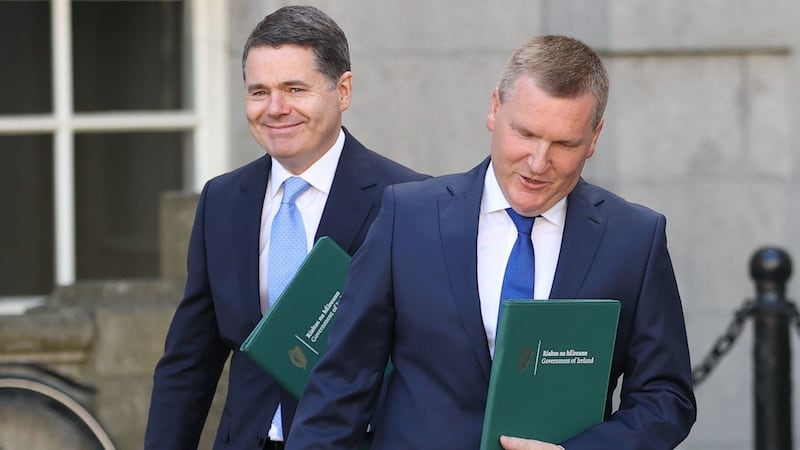If the first instinct of politicians is to throw money at a problem, no Irish government has ever thrown so much money at so big a problem.
Tuesday confirmed all the predictions: it was a massive budget. Nearly €18 billion, Paschal Donohoe boasted as he began his speech. Considering that budget day packages in recent years have been worth in and about €3 billion, this was something of a different order entirely.
As for the exact size, it depends on how you look at it. Government finances are not necessarily meant to be understood. About €8½ billion of that €18 billion was pre-committed to pay for the costs of Covid and, of that, more than €2 billion is in contingency funding. Another €3.4 billion will form the recovery fund, to be used as needed.

While the Government's intervention is a response to the pandemic, many of the measures announced will outlast it
Some of the increase in current spending was already baked in, the result of planned public sector pay increases and so on. But still. Even if the non-Covid increase in spending is “only” €5-6 billion, that’s still a massive budget. It feels wrong to call it a “giveaway budget”, because it’s not going to make anyone better-off – but it might stop them getting disastrously poorer.
The bottom line is that the cost of running the State exploded this year and next year will be same. The entire cost of that will be borrowed. A tsunami of borrowed money – €20 billion next year to follow a similar sum this year – is being pumped into the Irish economy to keep it afloat during the carnage wrought by Covid.
The economics is classically Keynesian – the State is stepping in to take the place of the private sector ravaged by the pandemic. There has never been such a scale of State intervention in the Irish economy in modern times.
Expenditure base
But while the Government’s intervention is a response to the pandemic, many of the measures announced will outlast it. For example, there is nearly €4 billion extra for health in Tuesday’s numbers.
Much of that will remain in the expenditure base after the pandemic recedes. This may very well be a good thing; but it will keep costing money, year after year.
How long can we continue to do this? Asked this on budget day, the response from the Ministers was: well, for next year anyway.
After that, who knows? The Government is borrowing so heavily not just because it wants to, but because external circumstances allow it to – central banks are standing behind more or less unlimited funding for governments. Moreover, the economic orthodoxy has changed from a decade ago, when countries scrambled to bring their public finances under control by slashing public spending and increasing taxes.
There was €50 million for everyone in the audience, so to speak
Perhaps central banks and financial markets will maintain this stance for as long as the pandemic continues. Perhaps not. Either way these decisions will be taken in the City of London, in Frankfurt, in Brussels maybe and in New York – not in Dublin.
Ireland and its government will always be price-takers in this game. So while the prevailing conditions are accommodating, Ireland will continue to borrow to get through the pandemic. Can you imagine the social upheaval if Ireland couldn’t borrow this money or could only borrow half of it? But if external conditions change, policy will have to change.
Political trap
But even without that, there is a danger that the Government is setting a political trap for itself. Even in the most optimistic version of the future, when a vaccine appears next year and economic activity rebounds, the Government will have to align its incomes and expenditures broadly over the medium term.
That means eliminating significant borrowing for current expenditure. The danger for the Government is that it is left in the aftermath of the pandemic with a smaller economy to finance a bigger state. But that is in the future. And this budget is principally a short-term fix, not a long-term plan.
Any budget has to work both politically and economically. How did this one do?
On its own terms, pretty okay. It marks an important test for the administration, which it passed. The budget was designed, agreed, delivered and sold with a coherence and co-operation between all sides of the administration that has not always – to put it mildly – been evident since the Government was formed just over three months ago.
The relative harmony is owed to two factors – first, the huge resources brought to bear meant that many of the usual scrappy budget rows over difficult decisions – €50 million here or €50 million there – were unnecessary. There was €50 million for everyone in the audience, so to speak. There is presumably a list somewhere of budget requests from Ministers that were turned down. But it doesn’t appear to be a very long one.
This generosity to supplicant Ministers has also helped with another process: the Coalition is coming together, discovering it must act with common purpose. This is a slow business, to be sure, but it is happening. The relationship between the two men who drew up the budget – similar in age, outlook, temperament and politics – is now one of the principal pillars of the Coalition. As the future bill for all this spending looms into view, and the country grapples with the social and economic challenges of the pandemic, much will depend on their axis in the future.
“The truth is this will be forgotten tomorrow,” says one person involved in the budget’s construction. “We’ll be back to how many cases was there today.”
Pat Leahy is political editor








